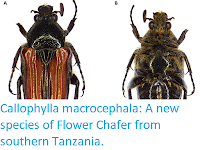Fringe-winged Beetle, Clambidae, are tiny Beetles (generally less than 2 mm in length) found on every continent except Antarctica. They get their common name from the fringe of long hairs surrounding their wings (they are also sometimes known as Minute Beetles). Fringe-winged Beetles have small heads and tend to be somewhat flattened, with some species able to roll into a ball in the same way as Pill Bugs. They are otherwise quite variable, with some species being hairy, others hairless or even scaly. The group are presumed to be ancient, as they are thought to have branched off from the Polyphagans (one of the four major divisions into which the Beetles as a whole are divided) early in that groups history, but their fossil record is sparse, with a since specimen known from Early Cretaceous Lebanese Amber, and several more from the Eocene Baltic and Bitterfeld ambers of Europe.
In a paper published in the journal Proceedings of the Royal Society Series B: Biological Sciences on 16 January 2019, Chenyang Cai of the Key Laboratory of Economic Stratigraphy and Palaeogeography at the Nanjing Institute of Geology and Palaeontology, and the School of Earth Sciences at the University of Bristol, John Lawrence of the Australian National Insect Collection, Shûhei Yamamoto of the Integrative Research Center at the Field Museum of Natural History, Richard Leschen of Landcare Research, Alfred Newton, also of the Integrative Research Center at the Field Museum of Natural History, Adam Ślipiński, also of the Australian National Insect Collection, Ziwei Yin of the Department of Biology at Shanghai Normal University, Diying Huang of the State Key Laboratory of Palaeobiology and Stratigraphy at the Nanjing Institute of Geology and Palaeontology, and Michael Engel of the Division of Entomology, Natural History Museum and Department of Ecology & Evolutionary Biology at the University of Kansas,, describe two new species of Fringe-winged Beetles from Cretaceous Burmese Amber.
Cretaceous ‘Burmese Amber’ has been extensively worked at several sites
across northern Myanmar (though mostly in Kachin State) in the last 20
years. The amber is fairly clear, and often found in large chunks,
providing an exceptional window into the Middle Cretaceous Insect fauna.
This amber is thought to have started out as the resin of a Coniferous
Tree, possibly a Cypress or an Araucaria, growing in a moist tropical
forest. This amber has been dated to between 105 and 95 million years
old, based upon pollen inclusions, and to about 98.8 million years by
uranium/lead dating of ash inclusions in the amber.
The first new species is placed in the still extant and widely distributed tropical genus Acalyptomerus, and given the specific name thayerae, in honour of Margaret Thayer of the Field Museum of Natural History, for her work on Rove Beetles. The species is named from three specimens, one male and two of uncertain sex, ranging from 1.05-1.15 mm in length, oval in shape with protuberant compound eyes. The margins of the elytra (wing cases) is serrated and lined with stiff setae (hairs).
The second new species is placed in the genus Sphaerothorax, which is again still extant, but today is restricted to Australia and New Zealand, and given the specific name uenoi, in honour of Teruhisa Ueno of Fukuoka in Japan, who donated one of the two specimens from which this species is described to the Field Museum of Natural History. The two known specimens of the species comprise one male and one of uncertain sex, both are about 0.71 mm in length, and covered in short hairs, which are denser along the margins of the elytra.
See also...
The first new species is placed in the still extant and widely distributed tropical genus Acalyptomerus, and given the specific name thayerae, in honour of Margaret Thayer of the Field Museum of Natural History, for her work on Rove Beetles. The species is named from three specimens, one male and two of uncertain sex, ranging from 1.05-1.15 mm in length, oval in shape with protuberant compound eyes. The margins of the elytra (wing cases) is serrated and lined with stiff setae (hairs).
Acalyptomerus thayerae from mid-Cretaceous Burmese amber. (a), (b), (d), (e) Under green epifluorescence; (c), (f ) under normal reflected light; (g)–(i) under transmitted light. (a), (c) Dorsal view of holotype (NIGP168027). (b) Ventral view of NIGP168027. (d), (f ) Dorsal view of paratype (NIGP168028). (e) Ventral view of NIGP168028. (g) Enlargement of holotype (NIGP168027), showing apical abdominal tergite. (h) The same as (g), showing apical sternite. (i) Z-staked image, showing male internal genitalia, including parameres (pm) and median lobe (ml). Cai et al. (2019).
The second new species is placed in the genus Sphaerothorax, which is again still extant, but today is restricted to Australia and New Zealand, and given the specific name uenoi, in honour of Teruhisa Ueno of Fukuoka in Japan, who donated one of the two specimens from which this species is described to the Field Museum of Natural History. The two known specimens of the species comprise one male and one of uncertain sex, both are about 0.71 mm in length, and covered in short hairs, which are denser along the margins of the elytra.
Sphaerothorax uenoi from mid-Cretaceous Burmese amber. (a)–(c) Under green epifluorescence; (d ) under red epifluorescence. (a) Dorsal view of holotype (NIGP168930). (b) Ventral view of NIGP168930. (c) Details of head of holotype, showing unframed compound eyes. (d ) Left elytron of holotype, showing dense strong setae. ely, elytron; ey, eye; mcp, metacoxal plate; pro, pronotum. Cai et al. (2019).
See also...
Follow Sciency Thoughts on
Facebook.








